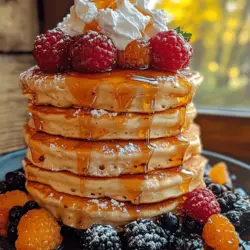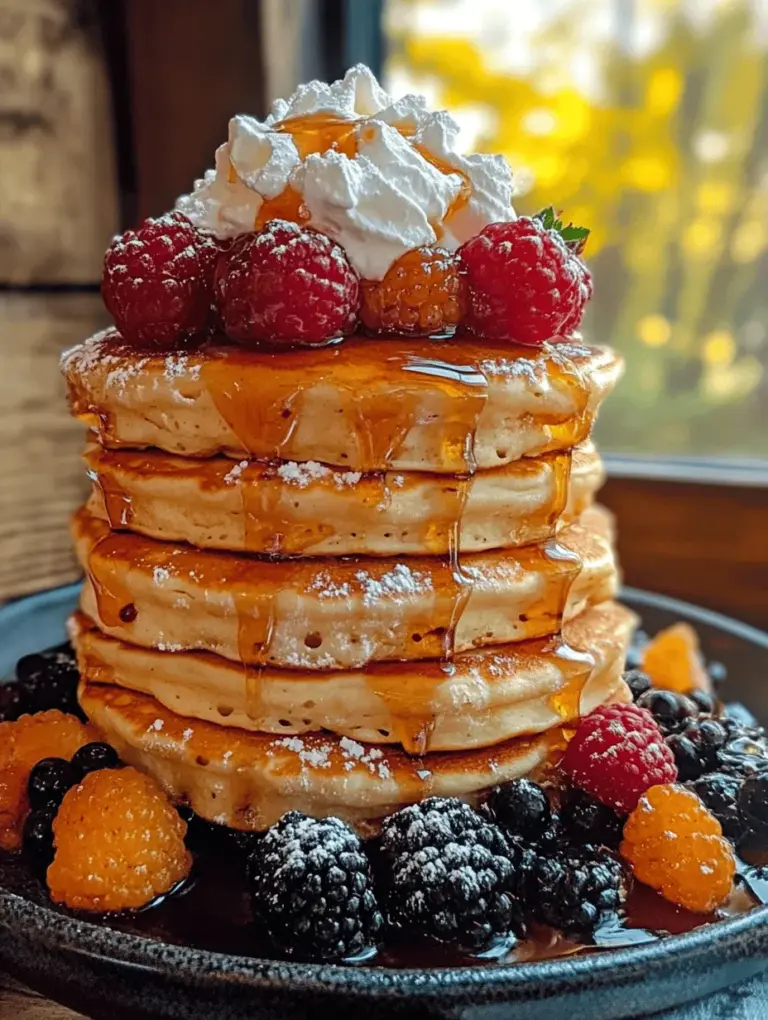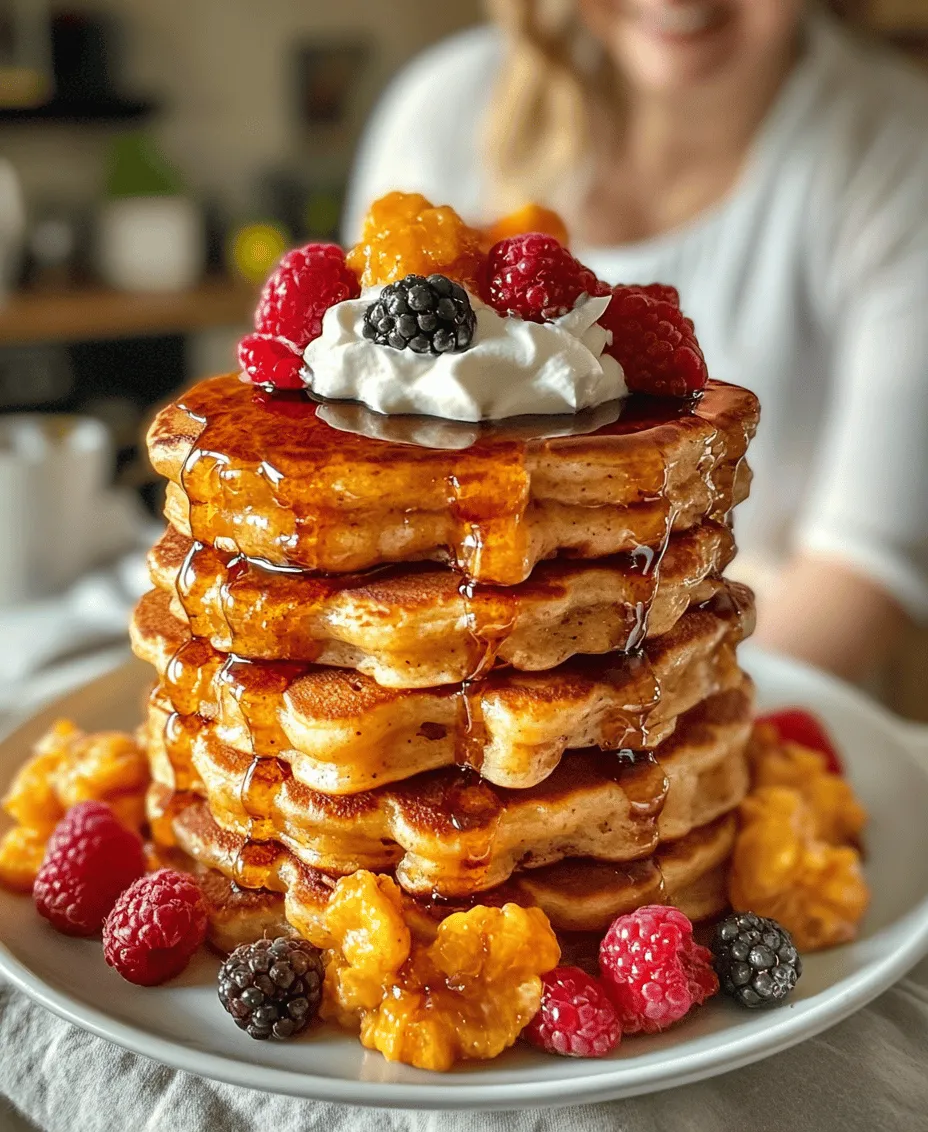In the fast-paced world we live in, finding time to prepare a delicious breakfast can often feel like a challenge. Mornings can be hectic, with alarm clocks ringing and the rush to get out the door. However, with this fluffy 5-minute pancake recipe, you can whip up a delightful meal in no time. These pancakes are not only quick to make but also incredibly light and fluffy, making them a perfect start to your day. Whether served with classic maple syrup or topped with fresh berries, this recipe promises satisfaction for the whole family.
Understanding Pancakes: A Brief History and Variations
Pancakes have a rich history that spans across cultures and centuries, making them one of the most beloved breakfast foods worldwide. The origins of pancakes can be traced back thousands of years, with early versions made from grains mixed with water and cooked over hot stones. Ancient Greeks and Romans enjoyed variations of pancakes, adding ingredients like honey and spices to enhance flavor.
As cultures evolved, so did pancake recipes. In France, the thin and delicate crêpe emerged, often filled with sweet or savory ingredients, while in the United States, the thick and hearty flapjack became a breakfast staple. Each culture has its unique take on this versatile dish, leading to an array of flavors, textures, and serving methods that cater to various tastes and preferences.
The Science Behind Fluffy Pancakes
Creating the perfect fluffy pancake isn’t just about the right technique; it also involves understanding the science behind the ingredients. The key components that contribute to the fluffiness of pancakes include all-purpose flour, baking powder, eggs, and liquids.
– All-Purpose Flour: This staple ingredient serves as the foundation for the pancake batter. When mixed with liquids, the flour’s proteins (gluten) develop, giving the pancakes structure. However, over-mixing can lead to tough pancakes; a gentle hand is essential.
– Baking Powder: As a leavening agent, baking powder plays a crucial role in creating that light, airy texture. When combined with moisture and heat, it releases carbon dioxide bubbles, causing the batter to rise and puff up during cooking.
– Eggs: Eggs not only bind the ingredients together but also contribute to the overall texture. They provide moisture and richness, helping pancakes to rise and achieve a fluffy consistency.
Gathering Your Ingredients: What You’ll Need
Before diving into the pancake-making process, it’s important to gather all the necessary ingredients. Here’s a breakdown of what you’ll need for these fluffy pancakes:
Essential Ingredients for Fluffy Pancakes
1. All-Purpose Flour: This is the best choice for pancakes due to its balanced protein content, which helps create a soft and fluffy texture.
2. Sugar: While sugar is often associated with sweetness, it also plays a crucial role in enhancing flavor and browning the pancakes during cooking.
3. Baking Powder: The leavening agent that makes a difference. It’s essential for achieving that light and airy texture that we all love in pancakes.
4. Salt: Just a pinch of salt helps to balance the sweetness and elevate the overall flavor of the pancakes.
Liquids That Make a Difference
1. Milk: The versatility of milk allows for both dairy and non-dairy options. Whole milk adds richness, while almond or oat milk can be used for a lighter alternative without sacrificing flavor.
2. Eggs: Eggs are integral for binding the ingredients together and contributing to the fluffiness of the pancakes.
3. Butter vs. Vegetable Oil: Both fats can be used in pancake recipes, but melted butter adds a rich flavor, while vegetable oil can create a slightly lighter texture.
Enhancing with Flavors
1. Vanilla Extract: A splash of vanilla extract can elevate the taste of your pancakes, adding a warm, sweet aroma that pairs perfectly with the other ingredients.
2. Popular Optional Toppings: While the pancakes themselves are delicious, they can be personalized with various toppings. Consider fresh berries, banana slices, whipped cream, chocolate chips, or nuts to enhance your breakfast experience.
The Step-by-Step Process: Making 5-Minute Pancakes
Now that you have gathered your ingredients, it’s time to make those fluffy pancakes! Before starting, it’s important to set up your kitchen efficiently to ensure a smooth cooking process.
Preparation: Setting Up Your Kitchen
1. Tools and Equipment Needed for Pancake Making: To make your pancake-making experience seamless, gather the following tools:
– Mixing bowls (for dry and wet ingredients)
– Whisk or fork (to mix the batter)
– Measuring cups and spoons (for accuracy)
– A non-stick skillet or griddle (for cooking)
– Spatula (for flipping pancakes)
2. Tips for Efficient Meal Prep in a Busy Kitchen:
– Measure out all your dry ingredients in advance to save time.
– Preheat your skillet or griddle while you mix your batter to ensure it’s hot and ready for cooking.
– Keep your toppings nearby for easy access once the pancakes are cooked.
Mixing the Dry Ingredients
1. In a mixing bowl, combine the all-purpose flour, sugar, baking powder, and salt. Whisk together until fully combined, ensuring there are no lumps.
2. Create a well in the center of the dry ingredients to prepare for adding the wet mixture. This technique helps to incorporate the liquids without over-mixing, which can lead to tough pancakes.
By following these initial steps and understanding the foundation of fluffy pancakes, you’re well on your way to creating a breakfast that is not only quick but also satisfying and delicious. Stay tuned for the next steps in our pancake-making journey, where we will explore mixing the wet ingredients and cooking the pancakes to perfection.
Achieving the Right Balance for Perfect Texture
To master the art of fluffy pancakes, achieving the right balance of ingredients is essential. The combination of flour, baking powder, and salt sets the foundation for your pancakes’ texture. Flour provides structure, while baking powder acts as a leavening agent, helping the pancakes rise during cooking. Salt enhances flavor and balances the sweetness, making each bite more enjoyable.
It’s crucial to use the correct ratio of dry ingredients. Too much flour can lead to dense pancakes, while too little can cause them to fall apart. For the best results, measure your flour using the spoon-and-level method: spoon flour into your measuring cup and level it off with a knife. This prevents packing and ensures an accurate measurement, leading to light and fluffy pancakes.
Avoiding Common Mistakes When Combining Dry Ingredients
When combining dry ingredients, it’s important to avoid clumping. To ensure even distribution, sift your flour with the other dry ingredients before mixing. This not only breaks up any lumps but also aerates the mixture, which contributes to a lighter pancake.
Another common mistake is mixing the dry ingredients too vigorously. Over-mixing can develop gluten in the flour, resulting in tough pancakes. Instead, gently fold the ingredients together until just combined. A few lumps in the batter are perfectly fine; they will cook out during the frying process.
Combining Wet Ingredients: Techniques for Success
The next step is to incorporate the wet ingredients into the dry mix. In a separate bowl, whisk together the eggs, milk, and melted butter. Whisking the wet ingredients separately ensures they are well combined before introducing them to the dry mixture. This technique helps achieve a uniform batter that bakes evenly.
When pouring the wet ingredients into the dry mixture, do this gradually while stirring gently. This method prevents the formation of large lumps and ensures that the batter is mixed thoroughly without overworking it. Remember, the goal is to have a smooth batter that is still somewhat thick—if it’s too runny, your pancakes may lose their fluffiness.
The Importance of Whisking for a Smooth Batter
Whisking is a vital step in pancake preparation. It not only combines the ingredients but also introduces air into the batter, which contributes to the fluffy texture. Use a standard whisk or a fork, and whisk until the batter is just combined. Avoid excessive whisking, as this can lead to gluten formation, making the pancakes chewy instead of fluffy.
If your batter has small lumps, don’t worry. A few lumps are acceptable and can lead to a more tender pancake. If you over-mix, your pancakes may become tough, so err on the side of caution and stop mixing as soon as the dry ingredients are moistened.
Understanding the Consistency of Pancake Batter
The ideal pancake batter should be thick enough to hold its shape on the skillet but still pourable. It should flow slowly from the spoon but not run too freely. If your batter seems too thick, you can add a little extra milk, one tablespoon at a time, until you reach the desired consistency. Conversely, if the batter is too runny, a sprinkle of flour can help thicken it up.
Cooking the Pancakes: Tips for the Perfect Flip
Once your batter is ready, it’s time to cook the pancakes. Preheat your skillet or griddle over medium heat. You can test the heat by sprinkling a few drops of water onto the skillet; if they sizzle and evaporate quickly, the skillet is ready for cooking.
Heat Management: How to Know When Your Skillet is Ready
Proper heat management is crucial for perfectly cooked pancakes. If your skillet is too hot, the outside will brown too quickly while the inside remains uncooked. If it’s not hot enough, the pancakes will take too long to cook and may end up dense.
A well-maintained medium heat is ideal for cooking pancakes. Adjust the temperature as needed if you notice your pancakes are browning too quickly or if they are taking too long to cook. Always allow the skillet to return to temperature between batches for consistent results.
Identifying When to Flip Pancakes for Optimal Cooking
Knowing when to flip your pancakes is key to achieving that perfect golden-brown color. Watch for bubbles to form on the surface of the pancakes. When the edges begin to look set and bubbles have formed throughout the pancake, it’s time to flip. Use a spatula to gently lift the pancake and flip it over. Cook for another 1-2 minutes until the second side is golden brown.
Serving Suggestions: Making Each Pancake a Masterpiece
Once your pancakes are cooked to perfection, it’s time to serve them up! There are countless creative ways to enhance your pancakes and make them a delightful breakfast experience.
Creative Topping Ideas for Every Taste
From classic maple syrup to innovative toppings, the options are endless. Here are some popular ideas to elevate your pancake game:
– Fresh Fruits: Top your pancakes with fresh berries, sliced bananas, or apple slices for a burst of flavor and nutrition.
– Nuts and Seeds: Sprinkle chopped nuts or seeds on top for added crunch and healthy fats.
– Yogurt or Whipped Cream: A dollop of yogurt or whipped cream adds creaminess and richness.
– Chocolate Chips: For a sweet twist, mix chocolate chips into the batter, or sprinkle them on top before serving.
– Nut Butters: Drizzle almond or peanut butter on top for added protein and flavor.
Pairing Pancakes with Beverages for a Complete Breakfast
To round out your breakfast, consider pairing your pancakes with complementary beverages. Here are a few suggestions:
– Coffee: A classic pairing that enhances the flavors of pancakes.
– Juice: Freshly squeezed orange juice or apple juice adds a refreshing touch.
– Milk: A glass of milk balances the sweetness of the pancakes and adds protein.
Nutritional Benefits of Pancakes: A Balanced Breakfast Option
Pancakes can be more than a treat; they can also be a nutritious breakfast option when prepared thoughtfully. Understanding their nutritional value can help you enjoy them guilt-free.
Understanding the Nutritional Value of Pancakes
A standard serving of pancakes (about two medium pancakes) typically contains around 200-300 calories, depending on the ingredients used. The macronutrient breakdown usually includes:
– Carbohydrates: Essential for energy, with approximately 30-40 grams per serving.
– Protein: Depending on the recipe, pancakes can provide about 5-10 grams of protein, especially if eggs or yogurt are included.
– Fat: Healthy fats can be included if you use whole milk or add nuts and seeds.
Highlighting the Benefits of Using Whole Ingredients
Using whole ingredients, such as whole wheat flour, can enhance the nutritional profile of your pancakes. Whole grains provide more fiber, which aids digestion and promotes satiety. Additionally, incorporating ingredients like yogurt or eggs can boost protein content, making your pancakes more filling.
Adding Nutrition: How to Make Pancakes Healthier
There are several ways to enhance the nutritional value of your pancakes without sacrificing taste.
Incorporating Whole Grains for Added Fiber
Substituting regular flour with whole wheat or oat flour increases fiber content, improving digestion and heart health. You can also experiment with alternative flours like almond or coconut flour for a gluten-free option that is also high in fiber.
Suggestions for Adding Fruits and Nuts to the Batter
Incorporating fruits and nuts directly into the batter can add flavor and nutrition. Blueberries, bananas, or grated apples are excellent additions that not only taste great but also provide vitamins and minerals. For a protein boost, consider adding chopped nuts or seeds, such as walnuts or flaxseeds, to the batter.
Common Pancake Questions: Troubleshooting Your Fluffy Pancakes
Even the best cooks encounter challenges while making pancakes. Here are some common questions and solutions to ensure your pancakes turn out perfectly every time.
Why Are My Pancakes Flat?
Flat pancakes can be a result of several factors, including expired baking powder or not enough leavening agent. Always check the freshness of your baking powder, and ensure you’re using the right amount. Additionally, ensure your wet ingredients are well incorporated, as this helps the pancakes rise.
Understanding Common Pitfalls in Pancake Making
Other common pitfalls include overmixing the batter or cooking at too high a temperature. Remember to mix until just combined and maintain a medium heat for optimal cooking.
How to Adjust Ingredients for Better Results
If you find your pancakes are still flat, consider increasing the baking powder slightly or letting the batter sit for a few minutes to allow the leavening agents to activate.
What If My Batter is Too Thick or Too Runny?
A thick batter can be adjusted by adding a little milk, one tablespoon at a time. Conversely, if your batter is too runny, add a small amount of flour and mix until you achieve the desired consistency.
Recognizing the Right Batter Consistency
The right pancake batter should be thick but pourable. If you’re unsure, err on the side of thicker, as it will hold its shape better during cooking.
Tips for Correcting Batter Texture on the Fly
If you find yourself in a bind with your batter, remember that you can always fix it! Keep flour or milk on hand to adjust accordingly, and don’t hesitate to experiment until you find the perfect consistency.
Conclusion: Enjoying Your 5-Minute Pancakes and Making Lasting Memories
In a world where time is often limited, this fluffy 5-minute pancake recipe shines as a beacon of simplicity and flavor. With just a few ingredients and minimal effort, you can create a breakfast dish that delights the senses and brings the family together. Enjoy experimenting with toppings and variations, making each pancake experience unique.
Let the joy of cooking quick and delicious meals inspire you to gather around the table and create lasting memories. Whether it’s a relaxed weekend brunch or a busy weekday breakfast, fluffy pancakes are a versatile dish that can cater to any occasion. Embrace the art of pancake making, and savor every delicious bite while cherishing the moments spent with loved ones.



